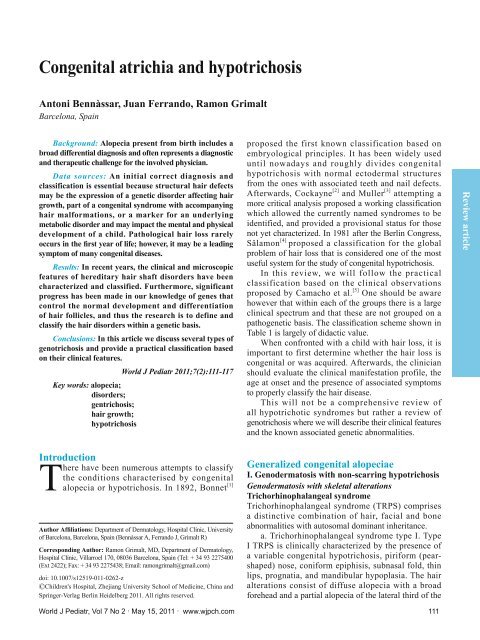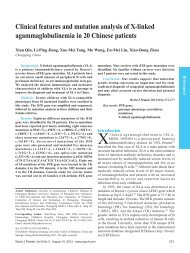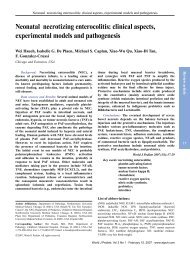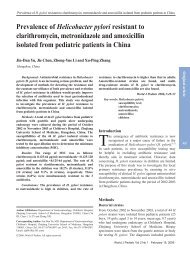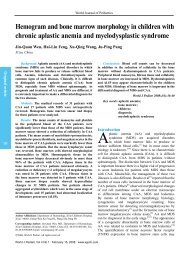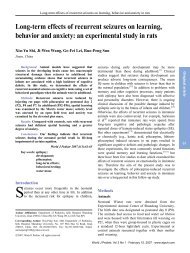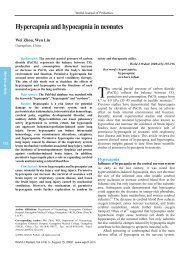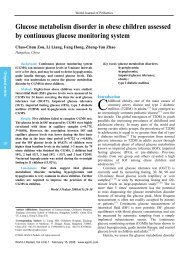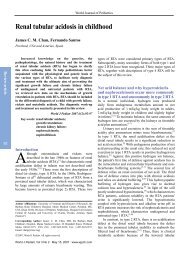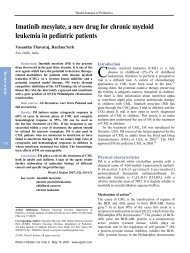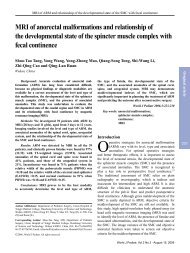Congenital atrichia and hypotrichosis - Springer
Congenital atrichia and hypotrichosis - Springer
Congenital atrichia and hypotrichosis - Springer
Create successful ePaper yourself
Turn your PDF publications into a flip-book with our unique Google optimized e-Paper software.
<strong>Congenital</strong> <strong>atrichia</strong> <strong>and</strong> <strong>hypotrichosis</strong><br />
<strong>Congenital</strong> <strong>atrichia</strong> <strong>and</strong> <strong>hypotrichosis</strong><br />
Antoni Bennàssar, Juan Ferr<strong>and</strong>o, Ramon Grimalt<br />
Barcelona, Spain<br />
Background: Alopecia present from birth includes a<br />
broad differential diagnosis <strong>and</strong> often represents a diagnostic<br />
<strong>and</strong> therapeutic challenge for the involved physician.<br />
Data sources: An initial correct diagnosis <strong>and</strong><br />
classification is essential because structural hair defects<br />
may be the expression of a genetic disorder affecting hair<br />
growth, part of a congenital syndrome with accompanying<br />
hair malformations, or a marker for an underlying<br />
metabolic disorder <strong>and</strong> may impact the mental <strong>and</strong> physical<br />
development of a child. Pathological hair loss rarely<br />
occurs in the first year of life; however, it may be a leading<br />
symptom of many congenital diseases.<br />
Results: In recent years, the clinical <strong>and</strong> microscopic<br />
features of hereditary hair shaft disorders have been<br />
characterized <strong>and</strong> classified. Furthermore, significant<br />
progress has been made in our knowledge of genes that<br />
control the normal development <strong>and</strong> differentiation<br />
of hair follicles, <strong>and</strong> thus the research is to define <strong>and</strong><br />
classify the hair disorders within a genetic basis.<br />
Conclusions: In this article we discuss several types of<br />
genotrichosis <strong>and</strong> provide a practical classification based<br />
on their clinical features.<br />
World J Pediatr 2011;7(2):111-117<br />
Key words: alopecia;<br />
disorders;<br />
gentrichosis;<br />
hair growth;<br />
<strong>hypotrichosis</strong><br />
proposed the first known classification based on<br />
embryological principles. It has been widely used<br />
until nowadays <strong>and</strong> roughly divides congenital<br />
<strong>hypotrichosis</strong> with normal ectodermal structures<br />
from the ones with associated teeth <strong>and</strong> nail defects.<br />
Afterwards, Cockayne [2] <strong>and</strong> Muller [3] attempting a<br />
more critical analysis proposed a working classification<br />
which allowed the currently named syndromes to be<br />
identified, <strong>and</strong> provided a provisional status for those<br />
not yet characterized. In 1981 after the Berlin Congress,<br />
Sâlamon [4] proposed a classification for the global<br />
problem of hair loss that is considered one of the most<br />
useful system for the study of congenital <strong>hypotrichosis</strong>.<br />
In this review, we will follow the practical<br />
classification based on the clinical observations<br />
proposed by Camacho et al. [5] One should be aware<br />
however that within each of the groups there is a large<br />
clinical spectrum <strong>and</strong> that these are not grouped on a<br />
pathogenetic basis. The classification scheme shown in<br />
Table 1 is largely of didactic value.<br />
When confronted with a child with hair loss, it is<br />
important to first determine whether the hair loss is<br />
congenital or was acquired. Afterwards, the clinician<br />
should evaluate the clinical manifestation profile, the<br />
age at onset <strong>and</strong> the presence of associated symptoms<br />
to properly classify the hair disease.<br />
This will not be a comprehensive review of<br />
all hypotrichotic syndromes but rather a review of<br />
genotrichosis where we will describe their clinical features<br />
<strong>and</strong> the known associated genetic abnormalities.<br />
Review article<br />
Introduction<br />
There have been numerous attempts to classify<br />
the conditions characterised by congenital<br />
alopecia or <strong>hypotrichosis</strong>. In 1892, Bonnet [1]<br />
Author Affiliations: Department of Dermatology, Hospital Clínic, University<br />
of Barcelona, Barcelona, Spain (Bennàssar A, Ferr<strong>and</strong>o J, Grimalt R)<br />
Corresponding Author: Ramon Grimalt, MD, Department of Dermatology,<br />
Hospital Clínic, Villarroel 170, 08036 Barcelona, Spain (Tel: + 34 93 2275400<br />
(Ext 2422); Fax: + 34 93 2275438; Email: ramongrimalt@gmail.com)<br />
doi: 10.1007/s12519-011-0262-z<br />
©Children's Hospital, Zhejiang University School of Medicine, China <strong>and</strong><br />
<strong>Springer</strong>-Verlag Berlin Heidelberg 2011. All rights reserved.<br />
Generalized congenital alopeciae<br />
I. Genodermatosis with non-scarring <strong>hypotrichosis</strong><br />
Genodermatosis with skeletal alterations<br />
Trichorhinophalangeal syndrome<br />
Trichorhinophalangeal syndrome (TRPS) comprises<br />
a distinctive combination of hair, facial <strong>and</strong> bone<br />
abnormalities with autosomal dominant inheritance.<br />
a. Trichorhinophalangeal syndrome type I. Type<br />
I TRPS is clinically characterized by the presence of<br />
a variable congenital <strong>hypotrichosis</strong>, piriform (pearshaped)<br />
nose, coniform epiphisis, subnasal fold, thin<br />
lips, prognatia, <strong>and</strong> m<strong>and</strong>ibular hypoplasia. The hair<br />
alterations consist of diffuse alopecia with a broad<br />
forehead <strong>and</strong> a partial alopecia of the lateral third of the<br />
World J Pediatr, Vol 7 No 2 . May 15, 2011 . www.wjpch.com 111
World Journal of Pediatrics<br />
Review article<br />
Table 1. Classification of generalized congenital <strong>and</strong> hereditary alopecia<br />
1 Genodermatosis with non-scarring <strong>hypotrichosis</strong><br />
1.1 With escheletical alterations<br />
McKusich disease or condrodisplasia<br />
Moynahan disease (<strong>hypotrichosis</strong>, sindactilia, retinitis)<br />
Trichorhinophalangeal syndromes<br />
Pierre-Robin syndrome<br />
Cardio-facial cutaneous syndrome<br />
Alopecia-contractures-dwarfism (ACD) syndrome with<br />
mental retardation<br />
Oculo-dental-digital syndrome<br />
Dubowitz syndrome<br />
Noonan syndrome<br />
Hallemann-Streiff syndrome<br />
1.2 With ectodermic alterations<br />
Ectodermal dysplasias<br />
1.3 With neuroectodermal alterations<br />
Tricothiodystrophy<br />
1.4 With chromosomal alterations<br />
Down syndrome<br />
Klinefelter syndrome<br />
Turner syndrome<br />
1.5 With aminoacid metabolism alterations<br />
Hypotrichosis, hair-shaft defects, hypercysteine hair <strong>and</strong><br />
glucosuria syndrome<br />
Citrulinemia<br />
Hartnup disease<br />
Homocistinuria<br />
Fenilcetonuria<br />
Tirosinemia I <strong>and</strong> II<br />
1.6 Other genodermatosis with <strong>hypotrichosis</strong><br />
1.6.1 Progeria<br />
Werner syndrome or pangeria<br />
Hutchinson-Gilford or childhood progeria<br />
Variot-Cailleau syndrome or childhood gerodermia<br />
Other progerias<br />
1.6.2 Others<br />
<strong>Congenital</strong> ichthyosiform eritrodermia<br />
Netherton syndrome<br />
Tay syndrome<br />
Rud syndrome<br />
KID syndrome<br />
Rothmund-Thomson disease<br />
Poikilodermia-alopecia-retrognatism-cleft palate syndrome<br />
Zinsser-Cole-Engman disease<br />
Kallin syndrome or epidermolysis bullosa simplex<br />
1.7 Genodermatosis with <strong>hypotrichosis</strong> <strong>and</strong> tumors<br />
Rombo syndrome<br />
Bazex-Dupré-Christol's syndrome<br />
1.8 Hereditary simple <strong>hypotrichosis</strong><br />
2 Genodermatosis with scarring <strong>hypotrichosis</strong><br />
2.1 Darier disease<br />
2.1 Ichthyosis X<br />
2.3 Distrofic epidermolisis bullosa<br />
2.4 Intontinentia pigmenti<br />
2.5 Poliostotic fibrous dysplasia<br />
2.6 Conradi syndrome<br />
2.7 Happle's syndrome<br />
eyebrows. Scanning electron-microscopic studies of<br />
the hair shaft can reveal flattened hair with an elliptoid<br />
transverse section pattern. Mechanical behavior of<br />
the hair might be abnormal with a significant increase<br />
in the viscous parameter, indicating a decreased<br />
intermolecular bridging within the keratin matrix. [6]<br />
b. Trichorhinophalangeal syndrome type II (Langer-<br />
Giedion syndrome). Patients with TRPS type II usually<br />
present <strong>hypotrichosis</strong> of the scalp hair, piriform nose <strong>and</strong><br />
redundant skin as the type I, plus multiple cartilaginous<br />
exostosis. In a recent article Lu et al [7] described<br />
associated alterations to this syndrome including aplasia<br />
of the epiglottis <strong>and</strong> congenital nephrotic syndrome.<br />
c. Trichorhinophalangeal syndrome type III. TRPS<br />
type III is a newly defined clinical entity [8] inherited as<br />
an autosomal dominant trait <strong>and</strong> clinically characterized<br />
by growth retardation, craniofacial abnormalities,<br />
severe brachydactyly <strong>and</strong> sparse hair. In addition,<br />
absence of mental retardation <strong>and</strong> cartilaginous<br />
exostoses are required for the diagnosis of TRPS type<br />
III. Other associated abnormalities include a short<br />
stature, a thin upper lip <strong>and</strong> a prominent lower lip, a<br />
pear-shaped nose, stubby fingers <strong>and</strong> toes with coneshaped<br />
epiphyses <strong>and</strong> sparse scalp hair.<br />
Dubowitz syndrome<br />
First described in 1965, [9] Dubowitz syndrome (DS) is<br />
characterized by a peculiar face, infantile eczema, small<br />
stature <strong>and</strong> mild microcephaly. The cutaneous findings<br />
consist of an eczematous eruption affecting the face<br />
<strong>and</strong> flexural areas. Scalp hair is sparse <strong>and</strong> brittle <strong>and</strong><br />
commonly affects the lateral eyebrows.<br />
Patients affected by DS have a moderate mental<br />
deficiency with a tendency toward hyperactivity, short<br />
attention span, stubbornness <strong>and</strong> shyness. They have<br />
also been characterized by their high-pitched weak cry.<br />
Hallermann-Streiff syndrome<br />
Hallerman-Streiff syndrome is a rare congenital anomaly<br />
characterized by a peculiar bird face, m<strong>and</strong>ibular <strong>and</strong><br />
maxillary hypoplasia, dyscephaly, congenital cataracts,<br />
microphtalmia, <strong>hypotrichosis</strong>, skin atrophy, <strong>and</strong> short<br />
stature. [10] Dental abnormalities are present in 80% of the<br />
cases <strong>and</strong> include malocclusion, crowding, severe caries,<br />
supernumerary <strong>and</strong> neonatal teeth, enamel hypoplasia,<br />
hypodontia, premature eruption of primary dentition,<br />
agenesis of permanent teeth, <strong>and</strong> anterior displacement<br />
or absence of condyles. [11]<br />
Genodermatosis with ectodermal alterations<br />
Ectodermal dysplasias<br />
The term ectodermal dysplasia was originally applied<br />
to anhidrotic ectodermal dysplasia in which hair, teeth,<br />
nails <strong>and</strong> sweat gl<strong>and</strong>s are defective. The classification<br />
proposed by Freire-Maya in 1977 [12] was based on a<br />
primary defect of ectodermal derivatives. Conditions<br />
in which the ectodermal changes are secondary, as in<br />
xeroderma pigmentosum are thus excluded from the<br />
ectodermal dysplasias. According to the Freire-Maia's<br />
classifications sub-group 1 is a hair dysplasia, subgroup<br />
2 a dental dysplasia, sub-group 3 a nail dysplasia,<br />
sub-group 4 a sweat gl<strong>and</strong> defect, <strong>and</strong> sub-group 5 a<br />
defect of other ectodermal structures.<br />
Solomon <strong>and</strong> Keuer in 1980 [13] defined subgroups<br />
of the ectodermal dyplasias based on what ectodermal<br />
structures were affected (Table 2).<br />
112<br />
World J Pediatr, Vol 7 No 2 . May 15, 2011 . www.wjpch.com
<strong>Congenital</strong> <strong>atrichia</strong> <strong>and</strong> <strong>hypotrichosis</strong><br />
Anhidrotic ectodermal dysplasia (Christ-Siemen-<br />
Touraine syndrome)<br />
In this X-linked syndrome sweat gl<strong>and</strong>s <strong>and</strong> other<br />
ectodermal-derived appendages are absent or few in<br />
number. The full syndrome only occurs in males. Scalp<br />
<strong>and</strong> body hair is short, fine <strong>and</strong> very sparse <strong>and</strong> often<br />
bright in colour, but may increase in quantity after<br />
puberty. Eyebrows <strong>and</strong> eyelashes may also be sparse<br />
or absent but may be relatively little affected. The<br />
prominent square forehead, saddle nose, thick lower<br />
lip <strong>and</strong> the pointed chin produce a distinctive face. The<br />
skin around the eyes is finely wrinkled <strong>and</strong> may be<br />
pigmented. The teeth may be absent or few in number,<br />
<strong>and</strong> characteristically the canines <strong>and</strong> incisors are<br />
conical shaped. The absent or reduced sweating leads<br />
to heat intolerance, <strong>and</strong> unexplained pyrexia may be the<br />
presenting symptom in infancy. Carrier females may be<br />
clinically normal but may show in some degree one or<br />
more of the features of the syndrome as conical teeth,<br />
<strong>hypotrichosis</strong> or heat intolerance. Otherwise apparently<br />
normal carriers may show dermatoglyphic abnormalities,<br />
the presence of which may be a value in diagnosis. [14]<br />
EEC syndrome (ectrodactily, ectodermal dysplasia<br />
<strong>and</strong> cleft lip <strong>and</strong> palate)<br />
The association of ectrodactyly (lobster-claw deformity),<br />
ectodermal dysplasia, <strong>and</strong> cleft lip <strong>and</strong> palate is a well<br />
defined autosomal dominant syndrome. [14]<br />
Reported EEC syndrome cases show sparse hair,<br />
malformed teeth with early caries, ectrodactyly, cleft<br />
lip <strong>and</strong>/or palate, lacrimal duct stenosis <strong>and</strong> kidney<br />
abnormalities, but not all defects are present in all<br />
Table 2. Ectodermal dysplasia subgoups proposed by Solomon <strong>and</strong> Keuer<br />
Subgroups 1, 2, 3 <strong>and</strong> 4 (Hair, teeth, nails <strong>and</strong> sweating defects)<br />
Anhidrotic ectodermal dysplasia<br />
Rapp-Hodgkin<br />
Ectrodactily-Ectpdermal dysplasia-Cleft palate syndrome<br />
Popliteal web syndrome<br />
Xeroderma-Talipes-Enamel defect syndrome<br />
Subgroups 1, 2 <strong>and</strong> 3 (Hair, teeth <strong>and</strong> nail defects)<br />
Clouston dysplasia<br />
Trichodento-osseous syndrome<br />
Ellis-van Creveld syndrome<br />
Ankyloblepharon-Ectodermal defects-Cleft palate syndrome<br />
Basan syndrome<br />
Tooth-nail syndrome<br />
Subgroups 1, 3 <strong>and</strong> 4 (Hair, nails <strong>and</strong> sweating defects)<br />
Freire-Maya's syndrome<br />
Subgroups 1 <strong>and</strong> 2 (Hair <strong>and</strong> teeth defects)<br />
Orofaciodigital syndrome I<br />
Sensenbrenner syndrome<br />
Trichodental syndrome<br />
Subgroups 1 <strong>and</strong> 3 (Hair <strong>and</strong> nail defect)<br />
Curly Hair-Ankyloblepharon-Nail Dysplasia syndrome<br />
Onychotrichodysplasia with neutropenia<br />
Subgroups 1 (Hair defects)<br />
Trichorhinophalangeal syndromes<br />
Dubowitz syndrome<br />
Moynahan syndrome<br />
affected individuals within a single family.<br />
Familial juvenile macular dystrophy with congenital<br />
<strong>hypotrichosis</strong> capitis<br />
Recently Becker et al [15] described two sisters in a family<br />
of consanguineous parents with diffuse <strong>hypotrichosis</strong> of<br />
the head <strong>and</strong> visual impairment in the context of a trichoocular<br />
malformation of an ectodermal dysplasia. This<br />
newly described entity will probably finally be included<br />
as a variant of other ectodermal dysplasia.<br />
Hypotrichosis with aminoacid metabolism alterations<br />
ectodermal dysplasia<br />
Hypotrichosis, hair-shaft structure defects, hypercysteine<br />
hair <strong>and</strong> glucosuria<br />
Blume-Peytavi et al [16] reported two Turkish siblings<br />
with fragile <strong>and</strong> sparse scalp hair associated with<br />
glucosuria without diabetes or kidney disease.<br />
Clinical examination revealed normal physical <strong>and</strong><br />
mental development, <strong>and</strong> an analysis of plucked hairs<br />
showed dysplastic <strong>and</strong> broken hair shafts. Polarizing<br />
microscopy <strong>and</strong> scanning electron microscopic studies<br />
revealed torsion, irregularities <strong>and</strong> impressions of the<br />
hair shaft, as seen in pili torti, trichorrhexis nodosa<br />
<strong>and</strong> pseudomonilethrix (Fig. 1). Analysis of the aminoacid<br />
composition of the hair demonstrated a significant<br />
reduction of sulphonic cysteic acid <strong>and</strong> an elevated<br />
cysteine <strong>and</strong> lanthionine content.<br />
Other genodermatosis with <strong>hypotrichosis</strong><br />
KID syndrome (keratitis, ichthyosis, deafness)<br />
The KID syndrome is a congenital ectodermal<br />
disorder that affects not only the epidermis, but<br />
also other ectodermal-derived tissues such as the<br />
corneal epithelium <strong>and</strong> the inner ear. In a classic<br />
review, [17] 61 patients who met the criteria for this<br />
syndrome were identified. All had cutaneous <strong>and</strong><br />
auditory abnormalities, <strong>and</strong> 95% of them also<br />
had ophthalmologic defects. The most frequent<br />
clinical features were neurosensory deafness (90%),<br />
erythrokeratoderma (89%), vascularizing keratitis<br />
(79%), alopecia (79%) (Fig. 2A), <strong>and</strong> reticulated<br />
hyperkeratosis of the palms <strong>and</strong> soles (41%) (Fig. 2B).<br />
In the same article, the authors state that the KID<br />
acronym does not accurately define this entity since the<br />
disorder is not an ichthyosis, because scaling is not the main<br />
cutaneous feature. In addition, not all patients have keratitis.<br />
They suggest that this syndrome should be included under<br />
the general heading of congenital ectodermal defects as a<br />
keratodermatous ectodermal dysplasia (KED).<br />
Genodermatosis with <strong>hypotrichosis</strong> <strong>and</strong> tumors<br />
Rombo syndrome<br />
First described by Michaëlsson in 1981, [18] Rombo<br />
Review article<br />
World J Pediatr, Vol 7 No 2 . May 15, 2011 . www.wjpch.com 113
World Journal of Pediatrics<br />
Review article<br />
syndrome is an autosomal dominant disease clinically<br />
characterized by <strong>hypotrichosis</strong> affecting the eyelashes<br />
<strong>and</strong> yellowish follicular facial papules. They also<br />
present cyanotic lips <strong>and</strong> multiple tricoepiteliomata <strong>and</strong><br />
basal cell carcinomas. [19]<br />
Bazex-Dupré-Christol's syndrome<br />
Bazex-Dupré-Christol's syndrome (BDCS) is an<br />
X-linked dominant disorder of the hair follicle<br />
characterized by follicular atrophoderma, multiple<br />
basal cell carcinomas, <strong>hypotrichosis</strong> (Fig. 3A), milia,<br />
<strong>and</strong> localized hypohidrosis. [20] Follicular atrophodermas<br />
(FA) are follicular depressions ("ice pick marks") seen<br />
most commonly on the dorsum of the h<strong>and</strong>s <strong>and</strong> elbows<br />
(Fig. 3B). In a recent article Kidd et al [21] described a<br />
Scottish family with this syndrome, with five affected<br />
members through three generations. The reported<br />
patients showed hypohidrosis confined to the face,<br />
coarse hair, dry skin, milia, <strong>and</strong> follicular atrophoderma.<br />
All the adults had a history of multiple basal cell<br />
carcinomas. None of them presented any skeletal<br />
feature suggestive of Gorlin's syndrome. The authors<br />
thus suggest that the BDCS should be considered as<br />
a differential diagnosis in patients with early onset or<br />
familial basal cell carcinomas.<br />
In 1994 Goeteyn et al [22] described 20 affected<br />
patients of a large family across four generations with<br />
typical features of the BDCS. However, the clinical<br />
picture in that family differs with regard to gender <strong>and</strong><br />
age, confirming an X-linked inheritance.<br />
Hereditary simple <strong>hypotrichosis</strong><br />
Hereditary simple hipotrichosis (HSH) is an uncommon<br />
group of familiar hypotrichias <strong>and</strong> <strong>atrichia</strong>s, usually<br />
non-scarring, which are not associated with other<br />
dysplasias neither with internal abnormalities. Although<br />
A<br />
Fig. 1. Pseudomonilethrix. Scanning electron microscopic studies reveal<br />
torsion, irregularities <strong>and</strong> impressions of the hair shaft.<br />
A<br />
B<br />
Fig. 2. KID syndrome. A: alopecia of the scalp, eyelashes <strong>and</strong> eyebrows;<br />
B: palmar keratoderma with a stippled-appearing surface pattern.<br />
A<br />
B<br />
Fig. 3. Bazex-Dupré-Christol's syndrome showing localised<br />
<strong>hypotrichosis</strong> (A) <strong>and</strong> follicular atrophoderma on the elbows (B).<br />
114<br />
Fig. 4. Brauer's nevus. <strong>Congenital</strong> unilateral triangular patch of alopecia<br />
in the frontotemporal region.<br />
World J Pediatr, Vol 7 No 2 . May 15, 2011 . www.wjpch.com
<strong>Congenital</strong> <strong>atrichia</strong> <strong>and</strong> <strong>hypotrichosis</strong><br />
most of them follow an autosomal dominant pattern,<br />
some may be recessive. [23]<br />
HSH usually presents as a congenital generalized<br />
<strong>hypotrichosis</strong> or <strong>atrichia</strong> showing a poor, sparse <strong>and</strong> dry<br />
hair aspect with long, isolated hairs remaining between<br />
extensive alopecic areas. Genot<strong>hypotrichosis</strong> of<br />
Villafranca de Duero is nearly the only localized form,<br />
affecting the scalp hair. [24]<br />
Recently described syndromes (non-classified disorders)<br />
In the last decade, several new hypotrichotic<br />
syndromes have been described with the title of "A<br />
new genodermatosis" or "A new syndrome". These<br />
have yet to be classified <strong>and</strong> included into the older<br />
classification schemes.<br />
<strong>Congenital</strong> ichthyosis with follicular atrophoderma<br />
In a recent article Lestringant et al [25] described five<br />
Emirati sibs (three girls <strong>and</strong> two boys), aged between<br />
4 <strong>and</strong> 18 years old, with normal stature, diffuse<br />
congenital ichthyosis, patchy follicular atrophoderma,<br />
generalized <strong>and</strong> diffuse non-scarring <strong>hypotrichosis</strong>,<br />
<strong>and</strong> marked hypohidrosis. Steroid sulfatase activity,<br />
assessed in the two boys, was found to be normal.<br />
Electron microscopic studies of ichthyotic skin did<br />
not show any specific abnormality. The patients were<br />
thought to have Bazex syndrome; however, ichthyosis<br />
is not a component of Bazex syndrome. They concluded<br />
that congenital ichthyosis with follicular atrophoderma<br />
represents a new autosomal recessive genodermatosis.<br />
<strong>Congenital</strong> <strong>atrichia</strong>, palmoplantar hyperkeratosis,<br />
mental retardation, <strong>and</strong> early loss of teeth<br />
Steijlen et al [26] reported four siblings with congenital<br />
<strong>atrichia</strong>, palmoplantar hyperkeratosis, mental<br />
retardation, <strong>and</strong> early loss of teeth. The pedigree in<br />
that family suggested an autosomal recessive trait.<br />
This combination of findings has not been previously<br />
reported <strong>and</strong> is therefore considered to be a new genetic<br />
entity.<br />
Keratoderma, <strong>hypotrichosis</strong> <strong>and</strong> leukonychia totalis<br />
Basaran et al [27] reported three relatives with congenital<br />
<strong>hypotrichosis</strong>, characterized by trichorrhexis nodosa<br />
<strong>and</strong> trichoptilosis, dry skin, keratosis pilaris <strong>and</strong><br />
leukonychia totalis. The described patients also<br />
developed a progressive transgrediens type of<br />
palmoplantar keratoderma, <strong>and</strong> hyperkeratotic lesions<br />
on the knees, elbows <strong>and</strong> perianal region.<br />
Alopecia-mental retardation syndrome associated with<br />
convulsions <strong>and</strong> hypergonadotropic hypogonadism<br />
Devriendt et al [28] reported two brothers with total<br />
congenital alopecia, mental retardation, childhood<br />
convulsions <strong>and</strong> hypergonadotropic hypogonadism.<br />
The authors believe that this association which has not<br />
previously been reported represents a new autosomal<br />
recessive condition.<br />
Universal congenital alopecia<br />
Complete or partial congenital absence of hair<br />
may occur either in isolation or with associated<br />
abnormalities. Most of the families with isolated<br />
congenital alopecia have been reported to follow an<br />
autosomal-recessive inheritance. In an attempt to map<br />
the gene for the autosomal recessive form, Nothem<br />
et al [29] performed genetic linkage analysis in a large<br />
inbred family from Pakistan where affected individuals<br />
showed a complete absence of hair. They mapped the<br />
gene for this hereditary form of isolated congenital<br />
alopecia on chromosome 8p21-22 (ALUNC [alopecia<br />
universalis congenitalis]). In a more recent article, [30]<br />
they reported an homozygous missense mutation in the<br />
human hairless gene. In addition, they found that the<br />
human hairless gene undergoes alternative splicing <strong>and</strong><br />
that at least two isoforms generated by alternative usage<br />
of exon 17 are found in human tissues. Interestingly, the<br />
isoform containing exon 17 is the predominant isoform<br />
expressed in all tissues except the skin, where they<br />
observed exclusive expression of the shorter isoform.<br />
The authors speculate that this tissue-specific difference<br />
in the proportion of hairless transcripts lacking exon 17<br />
sequences could contribute to the tissue-specific disease<br />
phenotype observed in individuals with this type of<br />
isolated congenital alopecia.<br />
<strong>Congenital</strong> <strong>hypotrichosis</strong> <strong>and</strong> milia<br />
Patients with congenital <strong>hypotrichosis</strong> <strong>and</strong> milia<br />
present with coarse sparse hair <strong>and</strong> multiple milia on<br />
the face, chest, axillae <strong>and</strong> pubic region. There are<br />
no abnormalities of teeth <strong>and</strong> nails. Polarizing light<br />
microscopy of hair shows an increased diameter of<br />
the hair shaft. Rapelanoro et al [31] reported a large<br />
four generations family where individuals presented<br />
with congenital <strong>hypotrichosis</strong> <strong>and</strong> multiple selfhealing<br />
milia. The family pedigree was compatible<br />
with an autosomal or an X-linked dominant mode of<br />
inheritance.<br />
II. Genodermatosis with scarring alopecia<br />
Happle syndrome<br />
Gobello et al [32] described a 13-year-old girl with<br />
chondrodysplasia punctata, associated with ichthyosis<br />
arranged along Blaschko's lines, follicular atrophoderma,<br />
cicatricial alopecia <strong>and</strong> coarse, lusterless hair. The<br />
patient also showed a congenital cataract in the right eye,<br />
dysplastic facial appearance <strong>and</strong> symmetrical shortening<br />
of the tubular bones. The pathogenetic concept of<br />
Review article<br />
World J Pediatr, Vol 7 No 2 . May 15, 2011 . www.wjpch.com 115
World Journal of Pediatrics<br />
Review article<br />
functional X-chromosome mosaicism introduced by<br />
Happle is used to name this syndrome.<br />
Localized congenital alopeciae<br />
<strong>Congenital</strong> triangular alopecia (Brauer's nevus)<br />
<strong>Congenital</strong> triangular alopecia (CTA) [33] is an unilateral<br />
or, less frequently, bilateral patch of alopecia in the<br />
frontotemporal region (Fig. 4). The age of onset<br />
varies between 3 <strong>and</strong> 5 year old <strong>and</strong> CTA should<br />
be differentiated from alopecia areata [34] <strong>and</strong> nevus<br />
sebaceous. Only about 47 cases have been reported,<br />
probably because the lesion is benign <strong>and</strong> nonprogressive.<br />
A frequency of 0.11% is reported by García-Hernández<br />
et al. [35] Males affected by CTA do not require treatment<br />
because of the later development of <strong>and</strong>rogenic alopecia,<br />
but women might benefit from surgical treatment.<br />
Aplasia cutis congenita (Adams-Oliver syndrome<br />
<strong>and</strong> other associations)<br />
Aplasia cutis congenita is a part of heterogeneous group<br />
of disorders characterized by the absence of a portion<br />
of skin in a localized or widespread area of the scalp at<br />
birth. It most commonly manifests as a solitary defect on<br />
the scalp, but sometimes it may occur as multiple lesions.<br />
Adams-Oliver syndrome<br />
Adams-Oliver syndrome depends on the association of<br />
aplasia cutis with terminal digital abnormalities namely<br />
shortening of fingers <strong>and</strong> toes, absence of phalangea or<br />
more rarely the absence of the entire extremity.<br />
A literature review [36] revealed a rate of 13.4% for<br />
congenital heart malformations in individuals with<br />
Adams-Oliver syndrome, suggesting that cardiac<br />
anomalies are a frequent manifestation of this syndrome.<br />
Thus, all patients with Adams-Oliver syndrome should<br />
be evaluated for cardiac abnormalities.<br />
Aplasia cutis congenita, high myopia, <strong>and</strong> cone-rod<br />
dysfunction<br />
Recently Gershoni-Baruch et al [37] reported two siblings<br />
with congenital nystagmus, cone-rod dysfunction, high<br />
myopia, <strong>and</strong> aplasia cutis congenita on the midline<br />
of the scalp vertex. The authors consider this familial<br />
oculocutaneous condition as a new unique autosomal<br />
recessive disorder.<br />
Nevus sebaceous<br />
Nevus sebaceus of Jadassohn is a benign, congenital<br />
hamartoma of the folliculo-sebaceous apocrine unit <strong>and</strong><br />
epidermis that often presents at birth, appears to regress<br />
in childhood, <strong>and</strong> grows during puberty, suggesting<br />
possible hormonal control. In childhood, the lesion<br />
consists of a circumscribed hairless yellow-orangecolored,<br />
waxy, pebble-like, papule or plaque often linear<br />
or round or irregular. In puberty the lesion becomes<br />
verrucous <strong>and</strong> nodular. Nevus sebaceous may develop<br />
tumors in adulthood particularly, syringocystadenoma<br />
papilliferum <strong>and</strong> benign hair follicle tumors. Basal cell<br />
carcinoma has been observed in about 5% of cases.<br />
Conclusion<br />
<strong>Congenital</strong> alopecia <strong>and</strong> <strong>hypotrichosis</strong> is present in<br />
a wide range of genetic conditions. It is important to<br />
have a framework of classification when evaluating a<br />
newborn with alopecia so that a correct diagnosis can<br />
be ascertained in a timely manner. When examining<br />
a child with alopecia, one must inspect for associated<br />
ectodermal anomalies or skeletal alterations. It is also<br />
necessary to have an underst<strong>and</strong>ing of the genetic<br />
basis of these conditions so that genetic testing can be<br />
performed when appropriate.<br />
Funding: No funding.<br />
Ethical approval: Not needed.<br />
Competing interest: None.<br />
Contributors: All authors contributed equally.<br />
References<br />
1 Bonnet R. Ueber Hypotrichosis congenital universalis.<br />
Anatomishe Hefte 1892;1:233.<br />
2 Cockayne AE. Inherited abnormalities of the skin <strong>and</strong> its<br />
appendages. Oxford: Oxford University Press, 1933: 229.<br />
3 Muller SA. Alopecia: syndromes of genetic significance. J<br />
Invest Dermatol 1973:60:475-492.<br />
4 Sâlamon T. Hypotrichosis <strong>and</strong> alopecia in cases of<br />
genodermatosis. In: Orfanos CE, Montagna W, Stüttgen G, eds.<br />
Hair Research Status <strong>and</strong> Future Aspects. Berlin: <strong>Springer</strong>-<br />
Verlag, 1981: 396-407.<br />
5 Camacho F. Genodermatosis with hyptrichosis. In: Camacho F,<br />
Montagna W, eds. Tricology. Madrid: Aula Médica, 1996: 219-<br />
236.<br />
6 Boni R, Boni RH, Tsambaos D, Spycher MA, Trueb RM.<br />
Trichorhinophalangeal syndrome. Dermatology 1995;190:152-<br />
155.<br />
7 Lu FL, Hou JW, Tsai WS, Teng RJ, Yau KI, Wang TR. Trichorhino-phalangeal<br />
syndrome type II associated with epiglottic<br />
aplasia <strong>and</strong> congenital nephrotic syndrome. J Formos Med<br />
Assoc 1997;96:217-221.<br />
8 Itin PH, Bohn S, Mathys D, Guggenheim R, Richard G.<br />
Trichorhinophalangeal syndrome type III. Dermatology<br />
1996;193:349-352.<br />
9 Paradisi M, Angelo C, Conti G, Mostaccioli S, Cianchini G,<br />
Atzori F, et al. Dubowitz syndrome with keloidal lesions. Clin<br />
Exp Dermatol 1994;19:425-427.<br />
10 Vadiakas G, Oulis C, Tsianos E, Mavridou S. A typical<br />
116<br />
World J Pediatr, Vol 7 No 2 . May 15, 2011 . www.wjpch.com
<strong>Congenital</strong> <strong>atrichia</strong> <strong>and</strong> <strong>hypotrichosis</strong><br />
Hallermann-Streiff syndrome in a 3 year old child. J Clin<br />
Pediatr Dent 1995;20:63-68.<br />
11 da Fonseca MA, Mueller WA. Hallerman-Streiff syndrome:<br />
case report <strong>and</strong> recommendations for dental care. ASDC J Dent<br />
Child 1994;61:334-337.<br />
12 Freire-Maya N. Ectodermal dysplasia revisited. Acta Genet<br />
Med Gemellol (Roma) 1977;26:121-131.<br />
13 Solomon LM, Keuer EJ. The ectodermal dysplasias. Arch<br />
Dermatol 1980;116:1295-1299.<br />
14 Jones EM, Hersh JH, Yusk JW. Aplasia cutis congenita,<br />
cleft palate, epidermolysis bullosa <strong>and</strong> ectrodactily: a new<br />
syndrome Pediatr Dermatol 1992;9:293-297.<br />
15 Becker M, Rohrschneider K, Tilgen W, Weber BH, Volcker<br />
HE. Familial juvenile macular dystrophy with congenital<br />
<strong>hypotrichosis</strong> capitis. Ophthalmology 1998;95:233-240.<br />
16 Blume-Peytavi U, Fohles J, Schulz R, Wortmann G, Gollnick<br />
H, Orfanos CE. Hypotrichosis, hair structure defects,<br />
hypercysteine hair <strong>and</strong> glucosuria: a new genetic syndrome Br<br />
J Dermatol 1996;134:319-324.<br />
17 Cáceres-Ríos H, Tamayo-Sanchez L, Duran-Mckinster C, de la<br />
Luz Orozco M, Ruiz-Maldonado R. Keratitis, ichthyosis, <strong>and</strong><br />
deafness (KID syndrome): review of the literature <strong>and</strong> proposal<br />
of a new terminology. Pediatr Dermatol 1996;13:105-113.<br />
18 Michaëlsson G, Olsson E, Westermark P. The Rombo<br />
syndrome: a familial disorder with vermiculate atrophoderma,<br />
milia, <strong>hypotrichosis</strong>, trichoepitheliomas, basal cell carcinomas<br />
<strong>and</strong> peripheral vasodilation with cyanosis. Acta Derm Venereol<br />
1981;61:497-503.<br />
19 Ashinoff R, Jacobson M, Belsito DV. Rombo syndrome:<br />
a second case report <strong>and</strong> review. J Am Acad Dermatol<br />
1993;28:1011-1014.<br />
20 Lacombe D, Taieb A. Overlap between the Bazex syndrome<br />
<strong>and</strong> congenital <strong>hypotrichosis</strong> <strong>and</strong> milia. Am J Med Genet<br />
1995;56:423-424.<br />
21 Kidd A, Carson L, Gregory DW, de Silva D, Holmes J,<br />
Dean JC, et al. A Scottish family with Bazex-Dupre-Christol<br />
syndrome: follicular atrophoderma, congenital <strong>hypotrichosis</strong>,<br />
<strong>and</strong> basal cell carcinoma. J Med Genet 1996;33:493-497.<br />
22 Goeteyn M, Geerts ML, Kint A, De Weert J. The Bazex-Dupre-<br />
Christol syndrome. Arch Dermatol 1994;130:337-342.<br />
23 Ferr<strong>and</strong>o J, Grimalt R. Hereditary simple <strong>hypotrichosis</strong>. In:<br />
Ferr<strong>and</strong>o J, Grimalt R. eds. Atlas of paediatric trichology.<br />
Madrid: Aula Médica, 2000: 64-65.<br />
24 Toribio J, quiñones PA. Hereditary <strong>hypotrichosis</strong> simplex of<br />
the scalp. Evidnce for autosomal dominant inheritance. Br J<br />
Dermatol 1974;91:687-696.<br />
25 Lestringant GG, Kuster W, Frossard PM, Happle R. <strong>Congenital</strong><br />
ichthyosis, follicular atrophoderma, <strong>hypotrichosis</strong>, <strong>and</strong><br />
hypohidrosis: a new genodermatosis Am J Med Genet<br />
1998;75:186-189.<br />
26 Steijlen PM, Neumann HA, der Kinderen DJ, Smeets DF, van<br />
der Kerkhof PC, Happle R. <strong>Congenital</strong> <strong>atrichia</strong>, palmoplantar<br />
hyperkeratosis, mental retardation, <strong>and</strong> early loss of teeth<br />
in four siblings: a new syndrome J Am Acad Dermatol<br />
1994;30:893-898.<br />
27 Basaran E, Yilmaz E, Alpsoy E, Yilmaz GG. Keratoderma,<br />
<strong>hypotrichosis</strong> <strong>and</strong> leukonychia totalis: a new syndrome Br J<br />
Dermatol 1995;133:636-638.<br />
28 Devriendt K, Van den Berghe H, Fryns JP. Alopecia-mental<br />
retardation syndrome associated with convulsions <strong>and</strong><br />
hypergonadotropic hypogonadism. Clin Genet 1996;49:6-9.<br />
29 Nothen MM, Cichon S, Vogt IR, Hemmer S, Kruse R, Knapp<br />
M, et al. A gene for universal congenital alopecia maps to<br />
chromosome 8p21-22. Am J Hum Genet 1998;62:386-390.<br />
30 Cichon S, Anker M, Vogt IR, Rohleder H, Pützstück M,<br />
Hillmer A, et al. Cloning, genomic organisation, alternative<br />
transcripts <strong>and</strong> mutational analysis of the gene responsible for<br />
autosomal recessive universal congenital alopecia. Hum Mol<br />
Genet 1998;7:1671-1679.<br />
31 Rapelanoro R, Taieb A, Lacombe D. <strong>Congenital</strong> <strong>hypotrichosis</strong><br />
<strong>and</strong> milia: report of a large family suggesting X-linked<br />
dominant inheritance. Am J Med Genet 1994;52:487-490.<br />
32 Gobello T, Mazzanti C, Fileccia P, Didona B, Papi M, Atzori<br />
F, et al. X-linked dominant chondrodysplasia punctata (Happle<br />
syndrome) with uncommon symmetrical shortening of the<br />
tubular bones. Dermatology 1995;191:323-327.<br />
33 Armstrong DK, Burrows D. <strong>Congenital</strong> triangular alopecia.<br />
Pediatr Dermatol 1996;13:394-396.<br />
34 de Viragh PA, Gianadda B, Levy ML. <strong>Congenital</strong> alopecia<br />
areata. Dermatology 1997;195:96-98.<br />
35 García-Hernández MJ, Rodríguez-Pichardo A, Camacho<br />
F. <strong>Congenital</strong> triangular alopecia (Brauer nevus). Pediatr<br />
Dermatol 1995;12:301-303.<br />
36 Zapata HH, Sletten LJ, Pierpont ME. <strong>Congenital</strong> cardiac<br />
malformations in Adams-Oliver syndrome. Clin Genet<br />
1995;47:80-84.<br />
37 Gershoni-Baruch R, Leibo R. Aplasia cutis congenita, high<br />
myopia, <strong>and</strong> cone-rod dysfunction in two sibs: a new autosomal<br />
recessive disorder. Am J Med Genet 1996;61:42-44.<br />
Received November 24, 2009<br />
Accepted after revision September 27, 2010<br />
Review article<br />
World J Pediatr, Vol 7 No 2 . May 15, 2011 . www.wjpch.com 117


